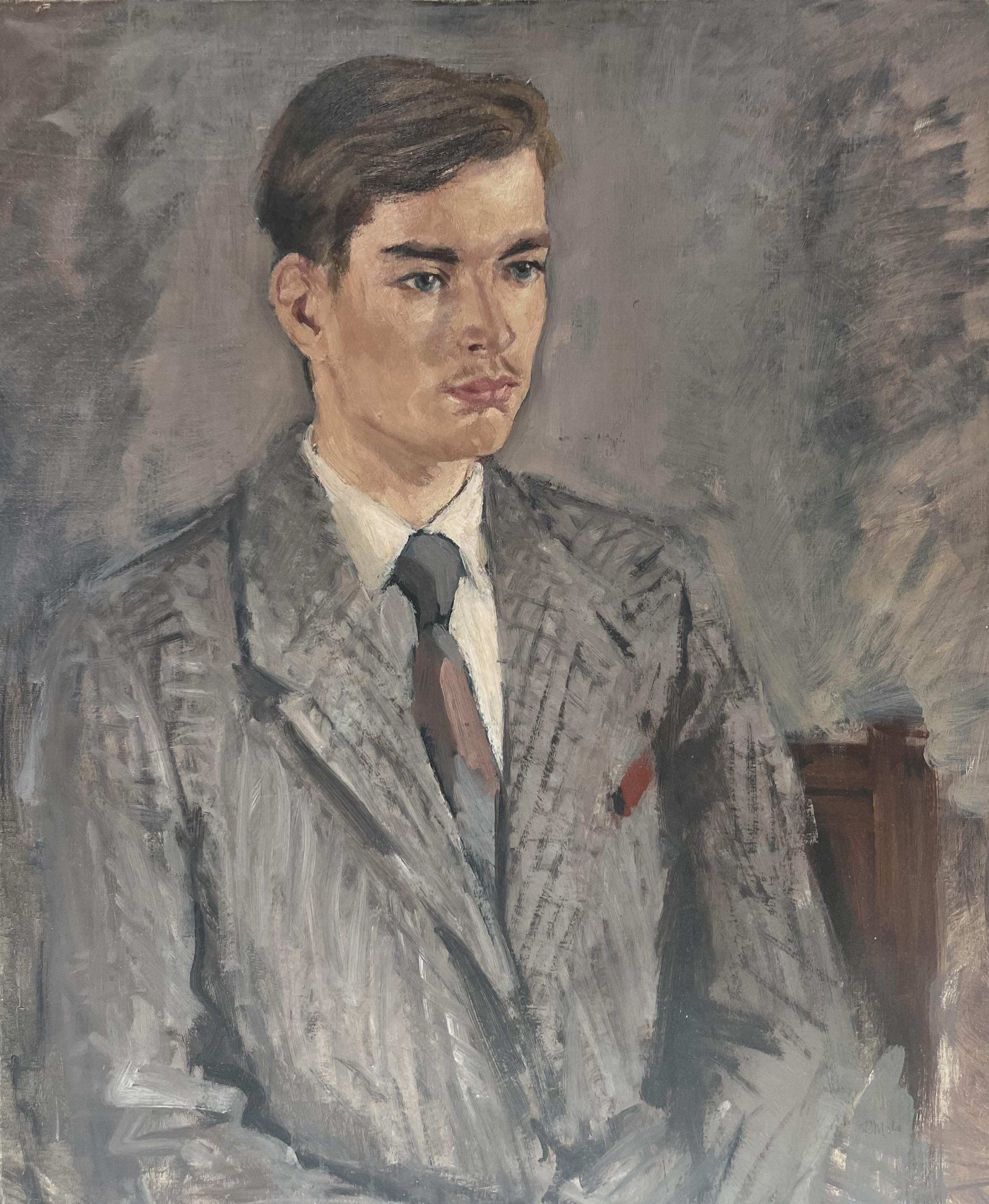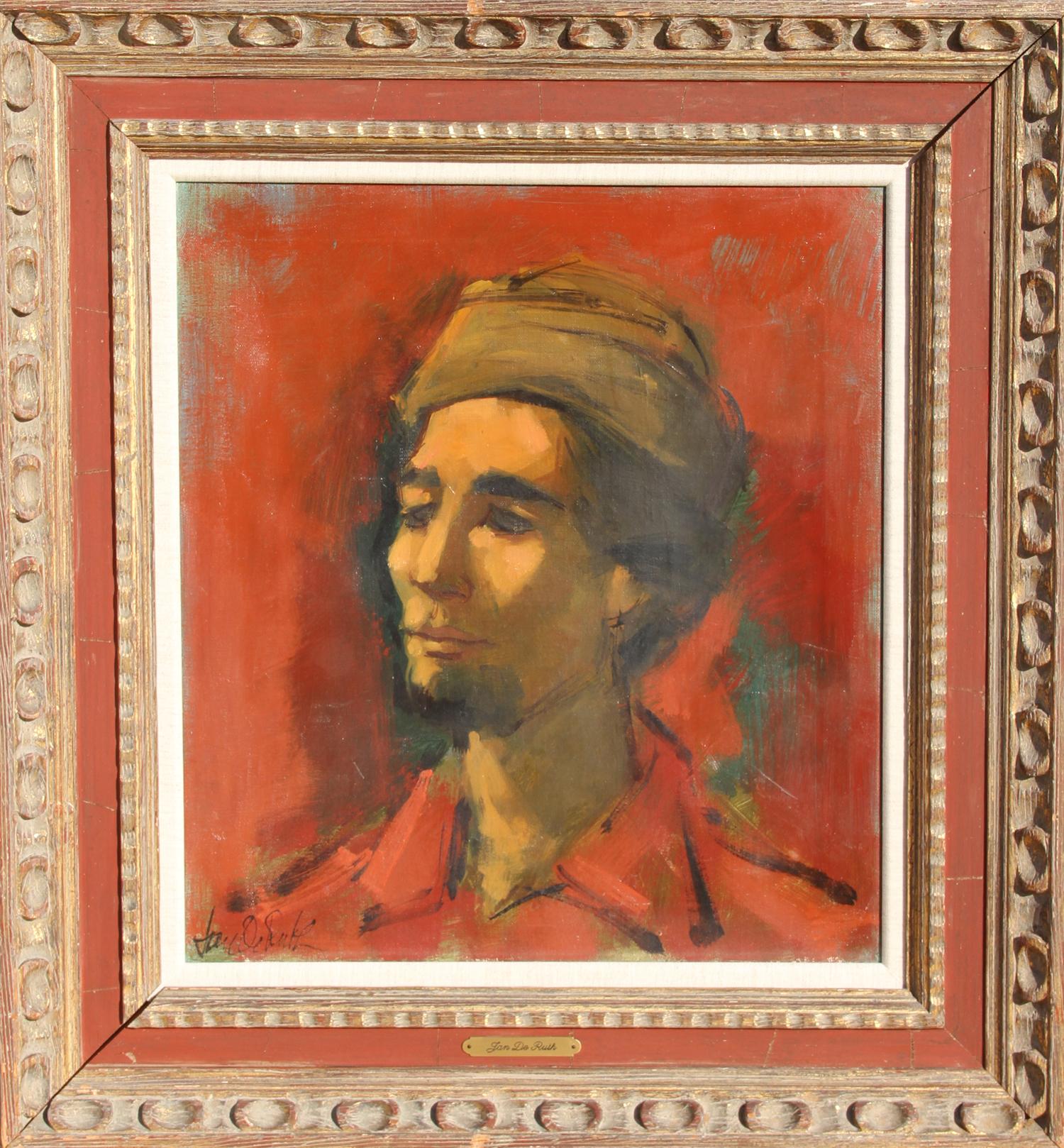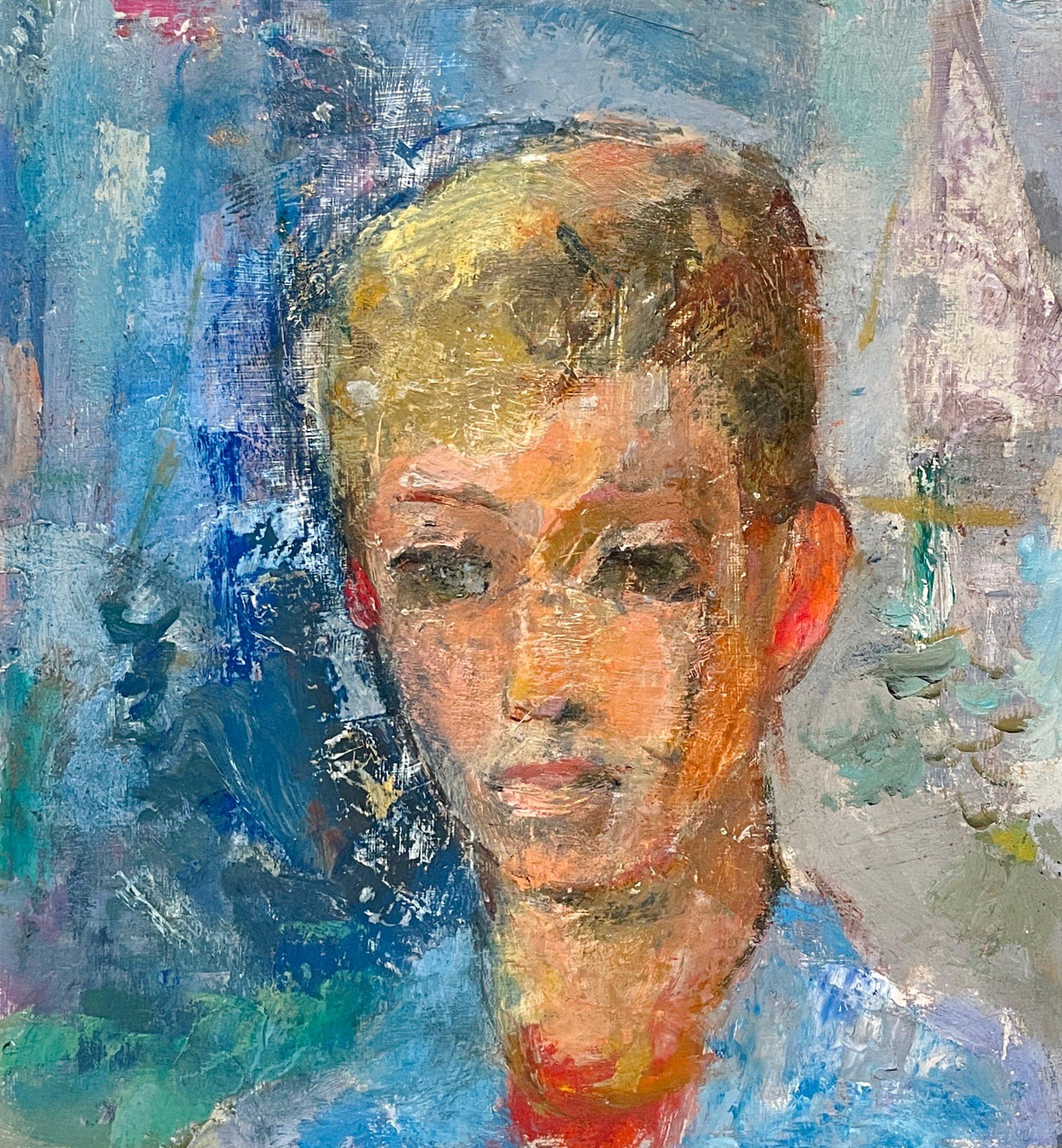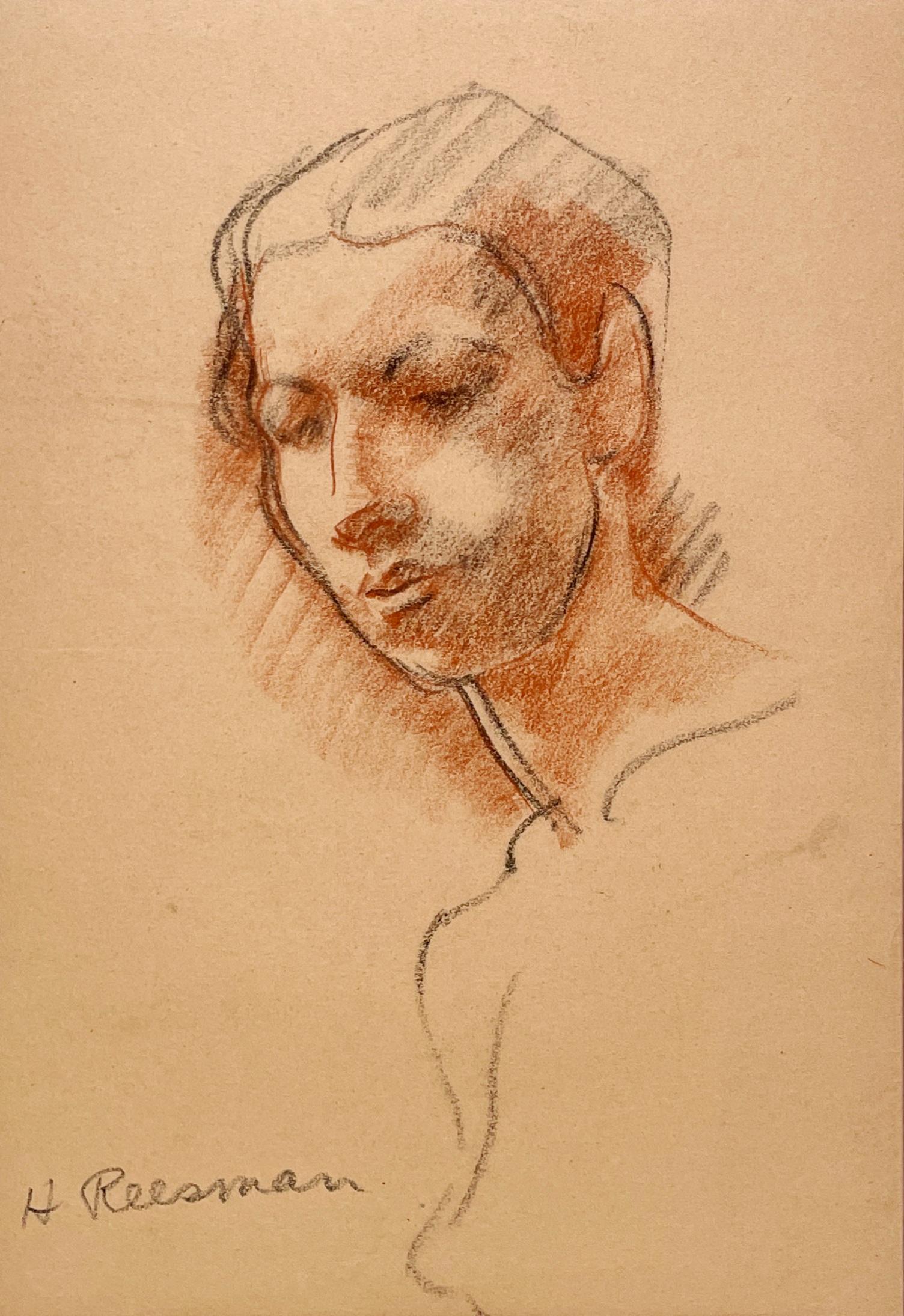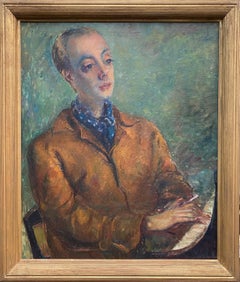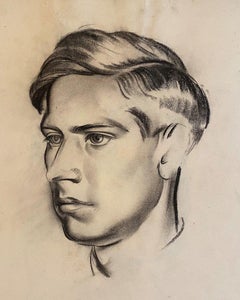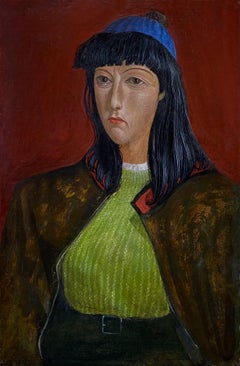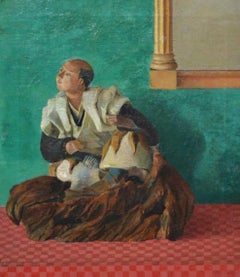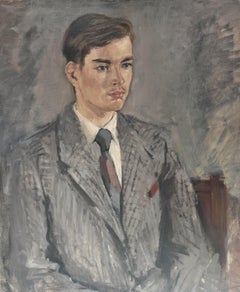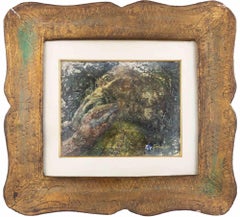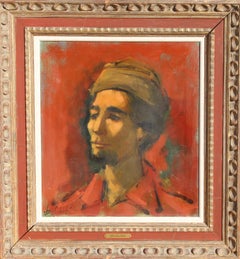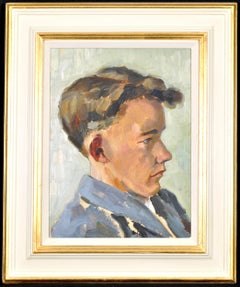Items Similar to Portrait of a Young Man Oil Painting Celebrated 20th Century Artist
Want more images or videos?
Request additional images or videos from the seller
1 of 7
Oliver MesselPortrait of a Young Man Oil Painting Celebrated 20th Century Artist1930
1930
$12,247.15
£9,000
€10,573.51
CA$16,825.51
A$18,784.09
CHF 9,842.58
MX$229,935.75
NOK 125,000.90
SEK 117,859.98
DKK 78,911.16
About the Item
Oliver Messel
1904 - 1978
Portrait of a Young Man
Oil on canvas, signed and dated 'Oliver Messel 1930' (on the stretcher)
Image size: 30 x 25 inches (76.2 x 63.4 cm)
Original frame
Oliver Messel was born to Leonard and Maud Messel, née Sambourne, on the 13 January 1904 and was the youngest of three children. The family moved to Nymans, the Messel family home in Sussex, from nearby Balcombe in 1915. The house remained in the family until 1953 when it was bequeathed to the National Trust, following a fire in 1947 which destroyed a large portion of the house.
The Messels originated from a line of German Jewish bankers on Leonard’s side, however, both family lines boast a number of artistic influences, including Maud’s father. Maud was brought up at 18 Stafford Terrace, Kensington (now known as the Linley Sambourne House Museum), amongst collections of antique porcelain and eighteenth-century furniture, and with a host of artistic visitors such as Henry Irving and Oscar Wilde.
Oliver’s own upbringing appears to be influenced by his mother's, as the Messel family were also affiliated with artists and writers and were keen collectors of art, filling their home with textiles, paintings and collections of European and Asian fans from travels abroad. It was amongst such treasures that Oliver, Anne and Linley spent their childhood, in addition to the beauty of Nyman’s extensive gardens.
Oliver was schooled at Eton but rather than going up to university was encouraged by family friends, gallery owner Archie Propert and painter and sculptor Glyn Philpot, to attend art school. In 1922 he enrolled at the Slade School of Fine Art in London, where he studied under Henry Tonks. Here, he met the artist Rex Whistler with whom he remained firm friends until Whistler’s death in WW2.
Upon leaving the Slade in 1924 Oliver was apprenticed to the studio of portrait artist John Wells, where he learnt various Old Master painting techniques, and met artists such as Jacob Epstein, Augustus John and William Orpen.
Whilst at the Slade Oliver developed his interest in Papier Mâché masks, a pastime popular amongst many art students at the time. Whilst apprenticed to artist John Wells several of Oliver’s masks were exhibited at the Claridge Gallery, London, alongside pieces by Whistler and other young artists. These were seen by Serge Diaghilev, director of the Ballet Russes, and Charles B. Cochran, a theatrical producer, both of whom made Oliver offers of work.
His first job in the theatre was creating masks for the Ballets Russes’ Zéphyr et Flore, 1925, designed by the French artist Georges Braque, followed by numerous musical revues for Cochran, including Wake Up and Dream!, 1929, with music by Cole Porter. It was during these revues, working with Porter and Noel Coward, that Oliver also began to design headdresses and costumes. In 1932 he was rewarded with his first full commission to design both costume and sets for Helen!, directed by Max Reinhardt. The production design is still celebrated today for its innovative approach and ground-breaking ‘white on white’ aesthetic, which referenced ‘Greek temples, Rococo drapes, Baroque colonnades and Louis XIV carousels’.
The success of Helen! led to further offers within the theatre including Reinhardt’s version of A Midsummer Night’s Dream at the Old Vic in 1937, starring Vivien Leigh as Titania and Robert Helpmann as Oberon, the Jean Cocteau play The Infernal Machine in 1940, and Christopher Fry’s translation of Jean Anouilh’s Ring Round the Moon, 1950.
One of Oliver’s best-known productions during this period was the Russian ballet The Sleeping Beauty, performed by Sadler’s Wells Ballet in 1946 at the Royal Opera House, Covent Garden. Encompassing over 200 costumes and four set changes, Oliver’s romantic designs were celebrated for bringing colour back to post-war London, and variations on his designs are still used today. Additional designs for the ballet included Comus in 1940, for which he was released from war duties, and Homage to the Queen, choreographed by Frederick Ashton and performed in 1953 for the Queen’s coronation.
His first opera was in 1940 for Mozart’s Die Zauberflöte at the Royal Opera House, followed by a series of productions at the newly founded Glyndebourne Opera House in Sussex, for which Oliver also designed the proscenium arch. He triumphed in 1956 designing a season of four different productions for their Mozart bicentennial, also providing illustrations for the programme covers.
His popularity also spread beyond theatre to film, were he worked on over eight different feature films including Romeo and Juliet, 1936, directed by George Cukor. During a three-month research trip to Italy Oliver collected over 3,000 reference images including postcards of artwork by Piero della Francesca, Giovanni Bellini and Leonardo da Vinci, along with prints and photographs of textiles and architectural features.
A production of Gabriel Pascal’s Caesar and Cleopatra, 1946, starring Vivien Leigh and Claude Rains, was celebrated for Oliver’s ability to recreate the opulence and luxury of ancient Egypt under the constraints of wartime rationing. Such was his skill that Vivien Leigh in a letter to Oliver declared that “I have of course told Pascal that nobody in the world must do the costumes except you.” He was later nominated for an Academy Award for his work on his final film Suddenly, Last Summer, 1959; an adaptation of Tennessee Williams’ American Southern Gothic mystery.
Having started his artistic career as a portrait apprentice, capturing the faces of family and friends, Oliver continued to develop this practice until the end of his life. His style is said to have been influenced by Glyn Philpot, the Messel’s family friend who encouraged Oliver from an early age in his pursuit of art and design. His most prolific period came in the 1950s during which he produced over 50 portraits, which were shown in exhibitions in New York, London and Barbados.
The exhibitions included both well-known faces and anonymous sitters captured on Oliver’s travels, and a number of these works have entered private collections. He continued to paint after moving to the Caribbean in 1966, capturing society figures and the rich and famous including fashion designer Carolina Herrera and Bianca Jagger. His style remained unchanged throughout his career, using the same soft painterly strokes and subtle palette as in his theatre designs.
By far his greatest contribution in addition to theatre and film was Oliver’s interior and architectural designs.
Another, much celebrated commission included Rayne shoe shop in Old Bond Street, where he created jewel-like interiors using the same practice of scaled models as his set designs. Other notable interior designs include those for Norwich and Bath Assembly Rooms, Flaxley Abbey in Gloucestershire, Rosehill Theatre in Cumbria and the Reader’s Digest offices in Paris.
However, upon moving to Barbados in 1966, Oliver embraced a new career envisioning architectural concepts for private houses, hotels and public buildings, utilising his experience with interior design to furnish them with bespoke items of furniture and textiles. His first project was Maddox, the deserted eighteenth-century plantation house bought by himself and his partner Vagn Riis-Hansen in 1964. The existing building and gardens were remodelled to Oliver’s designs embracing an inherent theatricality with views out to sea. These were framed by terraces and verandas which extended out from the living rooms creating what is often referred to as a Caribbean style of ‘indoor-outdoor’ living. For the woodwork he used a shade of green that is now known as ‘Messel green’ and often associated with the island of Barbados.
Oliver was born into a wealthy family; he travelled extensively and was exposed to art and culture from a young age. A privileged youth, his name is often mentioned amongst the ‘Bright Young Things’, for whom costume parties at country houses and jaunts to Europe on a whim became a thing of fable. This informal group included people such as Cecil Beaton (a life-long friend whom Oliver first met at Eton), Lord Berners, Noel Coward, John Betjeman, Harold Acton, Nancy Mitford, Edith Sitwell, Stephen Tennant, Rex Whistler and Evelyn Waugh, who famously satirised their exploits in the 1930s novel Vile Bodies. Having witnessed WW1, the 20s and 30s were a time of new freedom for these wealthy, artistic group of high society friends and acquaintances, who knew only too well how short life could be.
As with so many of his generation, Oliver’s life was significantly affected by WW2. In 1940 his artistic abilities were put to use as a Camouflage Officer in the Royal Engineers, learning various painting techniques for hiding buildings and vehicles. His skills were also used locally, disguising pillboxes in North Somerset. He was released from war service to undertake several design commissions including the ballet Comus and the film Caesar and Cleopatra.
Despite his privilege, Oliver’s life was also affected by social injustice. He was a gay man living at a time when his sexuality was deemed a criminal offence. As a man of wealth and connections he was able to be relatively open about his sexuality amongst family and friends, however, this would not have been the conditions under which most gay men and women lived at the time. Despite his relative openness, his life-long partner Vagn Riis-Hansen has not always been acknowledged in biographical accounts of Oliver's life. Their relationship is now recognised by the National Trust in their interpretation of the Messel family history, including Vagn in the family tree.
Oliver also lived through British Colonialism and having worked alongside black artists and performers, would have been acutely aware of the existence of significant racial inequality in British society. This is highlighted by his friendship with ‘King Freddie’, the 35th Kabaka of Buganda, who in 1953, was deposed by the British Government. Whilst the Kabaka was exiled in England, Oliver attempted to rent a flat in Mayfair for his friend, who was later refused entry by the landlord on the basis of race. In protest, Oliver began an extensive letter writing campaign to members of parliament and the press, highlighting the Kabaka’s treatment. The Kabaka eventually returned to his position and in 1955 Oliver and Vagn visited Buganda to attend the signing of a new treaty.
Oliver Messel died in Barbados on the 13 July 1978.
- Creator:Oliver Messel (1904 - 1978, British)
- Creation Year:1930
- Dimensions:Height: 30 in (76.2 cm)Width: 25 in (63.5 cm)
- Medium:
- Movement & Style:
- Period:
- Condition:
- Gallery Location:London, GB
- Reference Number:1stDibs: LU52415177972
About the Seller
5.0
Vetted Professional Seller
Every seller passes strict standards for authenticity and reliability
Established in 2007
1stDibs seller since 2014
82 sales on 1stDibs
Typical response time: 2 hours
- ShippingRetrieving quote...Shipping from: London, United Kingdom
- Return Policy
Authenticity Guarantee
In the unlikely event there’s an issue with an item’s authenticity, contact us within 1 year for a full refund. DetailsMoney-Back Guarantee
If your item is not as described, is damaged in transit, or does not arrive, contact us within 7 days for a full refund. Details24-Hour Cancellation
You have a 24-hour grace period in which to reconsider your purchase, with no questions asked.Vetted Professional Sellers
Our world-class sellers must adhere to strict standards for service and quality, maintaining the integrity of our listings.Price-Match Guarantee
If you find that a seller listed the same item for a lower price elsewhere, we’ll match it.Trusted Global Delivery
Our best-in-class carrier network provides specialized shipping options worldwide, including custom delivery.More From This Seller
View AllPortrait of Stanley Bate, 20th Century Musician
Located in London, GB
Oil on canvas
Image size: 24 x 29 inches (61 x 73.5 cm)
Contemporary style gilt frame
Provenance
From the estate of the artist, Clara Klinghoffer
This portrait is by an artist who propelled rapidly into the limelight after her first solo exhibition in 1920, at the age of 19, with the Daily Graphic naming her as the 'Girl Who Draws Like Raphael'. Yet today Clara Klinghoffer's name is little know.
Klinghoffer's early success resulted in numerous portrait commissions, including this one of the English composer Stanley Bate. The bold use of colour and naive execution of this portrait clearly reveals the modernist influence of fellow Jewish artists such as Bernard Meninsky, Jacob Kramer and Mark Gertler...
Category
20th Century Modern Portrait Paintings
Materials
Canvas, Oil
Portrait of a Young Man, 20th Century Graphite on Paper
By James Stroudley
Located in London, GB
James Stroudley
1906 -1985
Portrait of a Young Man
Graphite on paper
Image size: 18 x 16 inches
James Stroudley was born in London on 17 June 1906, the son of James Stroudley, showcard and ticket writer. He studied at Clapham School of Art (1923-27) and then at the Royal College of Art (1927-30), where his teachers included Alan Gwynne-Jones and William Rothenstein. As a recipient of the first Abbey Scholarship he was able to spend three years in Italy from 1930, where he absorbed the influences of Giotto and Piero della Francesca, and produced one of the last wholly satisfying decorative cycles by a Rome Scholar of the period. From 1934, he exhibited at the Royal Society of British Artists, and was elected to its membership in the following year.
From the Second World War – in which he worked with the Camouflage Unit – Stroudley taught at St Martin’s School of Art and was a visiting lecturer at the Royal Academy Schools. Though he continued to live in London, his later work, exhibited at the Royal Academy from 1955, indicated regular painting trips to Kent and Sussex coasts. However, much of his later work was abstract. In 1971, his former student, Peter Coker...
Category
20th Century Portrait Drawings and Watercolors
Materials
Paper, Graphite
Portrait of a Young Girl Oil Painting 20th Century
Located in London, GB
Circle of Thomas Derrick
British 1885 - 1954
Oil on panel
Image size: 21 1/2 x 14 inches (55 x 36 cm)
Hand made frame
Category
1950s Portrait Paintings
Materials
Oil
Figurine, 20th Century Oil on Board Signed Painting, Contemporary Frame
Located in London, GB
Mayer
20th Century
Figurine
Oil on board, signed lower right
Image size: 16 x 13 inches
Contemporary frame
Category
20th Century Figurative Paintings
Materials
Oil, Board
Self Portrait, Mid-20th Century Oil
Located in London, GB
Sheila Holland
1932-2002
Self Portrait
Oil on canvas, signed lower right
Image size: 30 x 22 inches
This is a wonderfully dynamic self portrait by the female artist Shelia Holland. ...
Category
Mid-20th Century Portrait Paintings
Materials
Oil
Portrait of a Boy, Pastel Drawing, 20th Century English
By William Dring
Located in London, GB
Pastel and graphite on paper
Image size: 11 x 8 1/2 inches (28 x 21.5 cm)
Mounted
William Dring
Dring was born with the forenames Dennis William, but was known colloquially as John. He was the brother of the artist James Dring. He married the painter Grace Elizabeth Rothwell...
Category
Mid-20th Century Portrait Drawings and Watercolors
Materials
Paper, Pastel, Graphite
You May Also Like
René Mels (1909-1977) Portrait of a young man, oil on canvas signed
Located in Paris, FR
René Mels (1909-1977)
Portrait of a young man,
signed lower right
oil on canvas
73 x 60 cm
Framed : 77.5 x 64.5
This impressive portrait is obviously tou...
Category
1940s Modern Portrait Paintings
Materials
Oil
Male Portrait - Paint by Fernando Porfili - 1961
Located in Roma, IT
Mixed media on canvas realized by Fernando Porfili (Porfirius) in 1961.
Hand signed and dated.
Includes a coeval wooden frame.
Very good condition.
Category
1960s Modern Figurative Paintings
Materials
Mixed Media
Portrait of the Artist as a Young Man, Modern Oil Painting by Jan de Ruth
By Jan De Ruth
Located in Long Island City, NY
Artist: Jan De Ruth, Czech (1922 - 1991)
Title: Portrait of the Artist as a Young Man
Year: circa 1964
Medium: Oil on Canvas, signed l.l.
Size: 20 in. x 18 in. (50.8 cm x 45.72 cm)
F...
Category
1960s Modern Portrait Paintings
Materials
Oil
Portrait of a Young Man - Modern British Impressionist Oil on Board Painting
Located in Sevenoaks, GB
* No US duty or taxes to pay on this item *
A beautiful 1950's Modern British oil on board portrait of a young man wearing a blue jacket. Excellent quality portrait which is present...
Category
1950s Portrait Paintings
Materials
Oil, Board
A Charming Mid-Century Modern Portrait of a Young Man by Francis Chapin
By Francis Chapin
Located in Chicago, IL
A Charming, 1960s Mid-Century Modern Portrait of a Young Man by Francis Chapin (Am. 1899-1965). With wonderful expressionist brushwork and a vibrant palette, the painting most like...
Category
Mid-20th Century American Modern Figurative Paintings
Materials
Masonite, Oil
A Fine 1946 Modern Portrait Figure Study of a Handsome Young Male Model / Artist
By Harold Haydon
Located in Chicago, IL
A Fine 1940s, Mid-Century Modern Academic Portrait Figure Study of a Handsome Young Male Model by Notable Chicago Artist, Harold Haydon (Am. 1909-1994). An exceptionally well execut...
Category
1930s American Modern Portrait Drawings and Watercolors
Materials
Paper, Charcoal, Pastel
More Ways To Browse
Olive Green Art
Jewish Portrait
German Paintings 1930s
Woodworking Painting
Portrait On Porcelain
Star Wars Painting
European Antique Portrait
Early 20th Century Italian Photographs
Portrait Of Leonardo
Bicentennial Art
Gay Portrait
Early 20th Century Childrens Portrait
Refer A Friend
Baroque Oil Painting Large
Italian Rococo Painting
Ww1 Art
Garden Party Painting
William Temple
